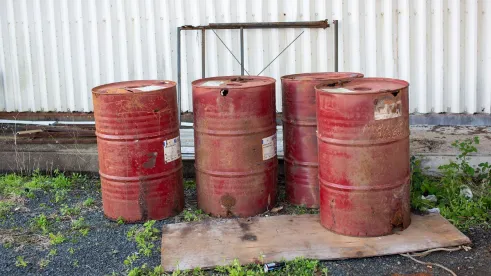Last year was busy with regulatory actions under the Toxic Substances Control Act (TSCA). This year promises to be even busier. Companies should make sure they are paying attention, including to comment deadlines for proposed rules.
EPA TSCA Resources
The U.S. Environmental Protection Agency (EPA)’s limited funding was the largest single factor affecting TSCA developments in 2022. EPA has stated that without substantially more financial resources, it will continue to miss its statutory deadlines under TSCA while still pushing forward with the resources it has. Two 2022 developments may lead to a better outcome in 2023.
First, EPA is working on a final rule to increase TSCA fees. EPA published a supplemental proposed fees rule on November 16, 2022. The current Regulatory Agenda, posted in January 2023, predicts the promulgation of a final rule by September 2023. If adopted as proposed, EPA would expect to receive about $45 million in TSCA fees during each of fiscal years (FYs) 2023 – 2025, or about 25% of its projected $181 million TSCA program expenses in each of those fiscal years. FY 2023 ends on September 30, so the new fee schedule will likely not take effect until the beginning of FY 2024 on October 1. Still, that would provide EPA with additional resources in the last quarter of calendar 2023. Fees increased automatically on January 1, 2022.
Under the supplemental proposal, for FYs 2023 – 2025, the fees for premanufacture notices (PMNs) and significant new use notices (SNUNs) would rise from $19,020 to $45,000 per substance; the fees for low volume exemption (LVE) applications would increase from $5,590 to $13,200 per substance; and the fees for EPA-initiated risk evaluations (to be shared by all manufacturers of the substance) would increase from $1,605,000 to $5,081,000 per substance. Lower fees would apply to small businesses.
Second, in the Consolidated Appropriations Act, 2023, Public Law 117-328 (Dec. 29, 2022), Congress increased funding for EPA’s toxics program, including TSCA, including $19.72 million more than the FY 2022 level of $98.06 million. (The FY 2022 increase was $4.0 million more than the FY 2021 appropriation.) This budget increase will help the TSCA program, but not solve EPA’s resource concerns. EPA’s FY 2023 budget request had asked for an increase of $64.0 million and 201 full-time-equivalent employees for the TSCA program.
PFAS, PFAS, PFAS
EPA is pouring resources into its ongoing efforts to implement its PFAS Strategic Roadmap (2021) using TSCA, although it has fallen behind its original timeline.
-
Final PFAS reporting rule under TSCA § 8(a)(7). The Regulatory Agenda predicts a final rule in March 2023, even though the deadline for comments on its Initial Regulatory Flexibility Analysis (IRFA) and Updated Economic Analysis for that rule was December 27, 2022. The IRFA projected a cost for the proposed rule of $875 million ($863,483,965 just for small businesses) for this one-time reporting rule. The IRFA identified regulatory alternatives under consideration, but EPA does not plan to issue a supplemental proposed rule. Section 8(a)(7) required a final rule by January 1, 2023. The proposal would require reporting 12 months after the rule’s effective date, i.e., by mid-2024. EPA may heed industry’s suggestions that a 12-month window is too short.
-
SNUR for inactive PFAS. EPA proposed a SNUR for all 330 inactive PFAS on the Inventory on January 26, 2023. Comments are due March 27. EPA could not publicly identify 30 of the 300 inactive PFAS, so more information may become available. The Regulatory Agenda predicts a final SNUR by December 2023.
-
Other PFAS SNURs. EPA published proposed SNURs for 35 PFAS already subject to section 5(e) orders on December 2, 2022. For the first time, EPA proposed to apply some SNUR provisions to the PMN submitters subject to the section 5(e) orders by waiving the usual exemption for PMN submitters in 40 C.F.R. § 721.45(i). The Regulatory Agenda does not predict a final rule date. This may be the first of several such SNUR proposals. The PFAS Strategic Roadmap said that EPA “plans to revisit past PFAS regulatory decisions and address those that are insufficiently protective. As part of this effort, the Agency could impose additional notice requirements to ensure it can review PFAS before they are used in new ways that might present concerns.”
-
Review of new PFAS. The PFAS Strategic Roadmap reports “EPA will apply a rigorous premanufacture notice review process for new PFAS to ensure these substances are safe before they enter commerce.” All new PFAS must undergo PMN review because in April 2021, EPA announced that it would no longer approve low volume exemption applications for PFAS, and in 2010 EPA amended the polymer exemption to exclude PFAS polymers. EPA is continuing its PFAS Low Volume Exemption Stewardship Program, announced in July 2021, to encourage LVE holders for PFAS to relinquish their exemptions.
-
PFAS testing. In October 2021, EPA released its National PFAS Testing Strategy. It announced plans for phased testing, first addressing health hazards, then ecological hazards. It identified 24 PFAS with an identifiable manufacturer(s) to whom EPA could issue a test order. So far, EPA has issued PFAS test orders for 6:2 fluorotelomer sulfonamide betaine (June 2022, corrected October 2022) and for hexafluoropropylene oxide (January 2023). EPA expects to issue test orders for all 24 PFAS and others, with about 45 test orders “expected to be associated with the Agency’s actions on PFAS” in FYs 2023 – 2025.
New Chemicals Program
EPA states that it particularly needs additional resources for the New Chemicals Program. As of February 1, 2023, 412 premanufacture notices (PMNs), significant new use notices (SNUNs), and microbial commercial activity notices (MCANs) awaited EPA review. This backlog is about 32% larger than the backlog as of January 1, 2022, which totaled 313 cases.
EPA plans to publish a proposed rule in July 2023 to update its PMN, SNUR, and MCAN regulations in light of the 2016 TSCA amendments, with a final rule projected for November 2024. The aim is to increase the quality of information initially submitted in new chemicals notices and improve EPA’s processes for the timely, effective completion of the risk assessment and the new chemicals review.
Significant New Use Rules
Aside from the PFAS SNURs mentioned above, EPA will continue to propose and adopt SNURs for PMN substances that have received section 5(e) orders. Section 5(f)(4) requires EPA either to initiate a SNUR for a substance within 90 days of issuing a section 5(e) order for it or to explain why it will not do so. EPA issued final SNURs for 32 substances with section 5(e) orders on December 2, 2022. It proposed SNURs for another 25 such substances on October 31, 2022. Expect more proposed and final SNURs in 2023.
The Regulatory Agenda predicts SNURs for high-priority substances for conditions of use identified as not currently ongoing in their final scope documents. The proposed SNURs are expected in April 2023, with final SNURs in March 2024. They would cover at least certain phthalates, flame retardants, and solvents. The final scope documents are available here.
Many SNURs and section 5(e) orders ban or limit releases to “waters of the United States.” 40 C.F.R. § 721.90. The final Waters of the United States (WOTUS) rule, published on January 18, 2023, amended the definition of that term referenced in 40 C.F.R. § 721.3. The amended definition takes effect on March 20, 2023. Persons subject to release restrictions may want to consider the possible impacts of the revised definition on their operations.
Risk Evaluations
By the end of the Trump Administration, EPA had “completed” risk evaluations for the initial 10 substances and initiated risk evaluations for 20 high-priority substances. (For asbestos, EPA completed its risk evaluation for ongoing uses of chrysotile asbestos, but it only issued the final scope document for its ongoing risk evaluation for legacy uses of asbestos in June 2022). Under the Biden Administration, EPA has been revising the risk determinations (part of the risk evaluations) for all of the initial 10 other than that for chrysotile asbestos. It has issued final revised risk determinations for carbon tetrachloride, HBCD, methylene chloride, Pigment Violet 29, and trichloroethylene. Additionally, it has posted a draft of revised risk determinations for 1-bromopropane, n-methylpyrrolidone, and perchloroethylene. EPA expects to issue a draft revised risk determination for 1,4-dioxane in early 2023.
Meanwhile, EPA continues to prepare draft risk evaluations for the 20 high-priority substances. It has not explained when it expects to issue the drafts. EPA Congressional testimony in June 2022 indicated that “it is unclear whether EPA will even be able to complete half of [these 20 risk evaluations] before 2025.” The FY 2022-2026 EPA Strategic Plan identifies a long-term goal that “[b]y September 30, 2026, [EPA will] complete at least eight High Priority Substance (HPS) TSCA risk evaluations annually within statutory timelines compared to the FY 2020 baseline of one.” Nevertheless, EPA may issue draft risk evaluations for one or more of the 20 this year. Despite the absence of a currently open comment period, stakeholders may want to submit additional information to EPA during 2023 to influence the draft, and later final, risk evaluations.
EPA plans to propose revisions to its framework regulation on risk evaluations, 40 C.F.R. Part 702, Subpart B, in May 2023.
Risk Management Rulemaking
With the completion or near completion of risk evaluations for the 10 initial substances, expect a flurry of risk management rulemaking in 2023 for those substances.
Of all the 10 initial substances, chrysotile asbestos is furthest along in the risk management process. EPA proposed a risk management rule in April 2022. It plans to adopt a final rule in October 2023.
The Regulatory Agenda predicts that EPA will issue proposed risk management rules for:
-
Methylene chloride in February 2023, with a final rule in August 2024
-
Perchloroethylene in April 2023, with a final rule in August 2024
-
Carbon tetrachloride in May 2023, with a final rule in August 2024
-
Trichloroethylene in June 2023, with a final rule in September 2024
-
1-Bromopropane in September 2023, with a final rule in August 2024
-
N-methylpyrrolidone in September 2023, with a final rule in August 2024
The Regulatory Agenda does not predict risk management rules for Pigment Violet 29, 1,4-dioxane, or HBCD. Presumably, EPA expects to issue proposed rules for those substances in 2024. Despite the absence of a currently open comment period, stakeholders may want to submit additional information to EPA during 2023 to influence the proposed, and later final, risk management rules.
EPA plans to propose amendments to the 2021 final rules for five persistent, bioaccumulative, and toxic substances (PBTs), 40 C.F.R. Part 751, Subpart E, by November 2023, with final amendments expected in September 2024. A particular focus of this rulemaking is likely to be compliance deadlines for PIP (3:1) and decaBDE. Despite the absence of a currently open comment period, stakeholders may want to submit additional information to EPA during 2023 to influence the proposed, and later final, amendments to the PBT rules.
In March and September 2022, EPA proposed to update incorporations by reference in its rules on formaldehyde in composite wood products, 40 C.F.R. Part 770. EPA expects to finalize the proposals in December 2023.
In May 2023, EPA plans to publish final amendments to its PCB rules expanding the available options for extraction and determinative methods used to characterize and verify the cleanup of PCB waste.
Reporting Rules
As noted above, EPA predicts publishing the final PFAS reporting rule in March 2023.
It expects to promulgate a final reporting and recordkeeping rule for asbestos in May 2023. The proposed rule appeared in May 2022.
The next Chemical Data Reporting rule (CDR) report is due between June 1 and September 30, 2024. That makes 2023 the principal reporting year for that report. Manufacturers should ensure that they keep the records that will enable them to report in 2024.
EPA plans to propose a rule to establish a framework of data reporting requirements to:
-
Collect information beyond the basic screening-level CDR data, including health and safety studies and exposure monitoring data;
-
Provide a more robust description of the supply chain, potentially including information from processors and about other situations (e.g., articles, byproducts) exempted from CDR, with the intent to more comprehensively identify the conditions of use to be evaluated for each chemical; and
-
Provide more detailed information needed for risk evaluations associated with the manufacture, processing, use, and disposal of each chemical.
The rule would establish a series of reporting obligations for certain chemicals based on their position in the existing chemicals evaluation process (prioritization, risk evaluation, risk management). As chemicals move through that evaluation process, they may be made subject to the appropriate reporting requirement. EPA projects this proposal will come in January 2024, with a final rule in May 2025.
Testing Requirements
A technical support document for the November 2022 supplemental proposed fees rule laid out an ambitious program to require testing under TSCA:
The Agency believes it is reasonable to assume that approximately 75 test orders per year will be initiated between fiscal year 2023 and fiscal year 2025. Approximately 45 of these test orders are expected to be associated with the Agency’s actions on PFAS. EPA’s estimate for the number of test orders increased from the 2018 Fee Rule which assumed 10 test orders per year. This increase in test orders will be needed to close any relevant data gaps identified in the Prioritization process or the Scoping stage of the risk evaluation process for High-Priority Substances, for which EPA expects to have 20 EPA-initiated risk evaluations and three manufacture-requested risk evaluations going on each year. Furthermore, EPA anticipates issuing additional collection activities through TSCA section 4 to address EPA’s priorities, such as generating information to inform the Agency’s understanding of PFAS. In addition, the EPA assumed two test rules and two ECAs between fiscal year 2023 and fiscal year 2025 based on recent experience implementing amended TSCA.
Since 2020, EPA has issued test orders for 12 substances. They are for Pigment Violet 29; 2 PFAS; and 9 high-priority substances.
Confidential Business Information
In sum, expect to stay busy tracking and responding to EPA actions under TSCA throughout 2023.





 />i
/>i

